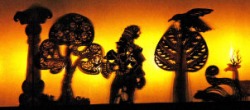Tholpaavakoothu

Originated in the 18th century, Tholpavakoothu is also known as pavakoothu (puppet play) or nizhalattam (shadow play). In Tholpavakoothu, puppets (pavakal) made of deer skin are arranged behind a long white screen in front of bright wick lamps. It usually represents four characters from the Ramayana. The puppets are made to dance to the accompaniment of songs from the Tamil version of the Ramayana. The performance starts late at night and continues up to daybreak.
The myth behind this art form goes like this. Goddess Bhadrakali was busy fighting the demon Tarakasura when Rama was fighting Ravana. So, she could not see the Lanka war. Lord Shiva advised her to visit temples where the battle would be re-enacted in puppet shows. Hence, these puppet shows are shown in Bhagavati temples. And since the whole puppet show is an re-enactment, a shadow of the original, we have shadow puppetry. The curtain on which the shadows are projected faces the deity. All Bhagavati temples have permanent stages for puppet shows. The stage is called the ‘Koothu Madam.’ It is 42 feet long, 12 feet wide and 8 feet high. The puppets are behind the curtain and oil lamps are used to light up the scene behind the curtain.
Originally, puppets were made of palm leaves, and later deer skin was used. There used to be six sangams or associations of puppeteers in Kerala — Mathur, Puthur, Kavalapara, Kuthanur, Palapuram and Payaloor.The puppet is moved by a stick fixed on it vertically. The puppets are in different postures. They are 180 cm high and 45 cm wide. Instruments such as chendai, madhalam, kuzhal, thattam, bombu, chellinga and ezhupara are used. In the course of the show, the audience might have some questions for the main puppeteer.Tholpavakoothu is staged continuously for 7, 14, 21, 41, or 71 days, depending upon the custom practised in the temple. Earlier, shows used to be of ten hours duration. Now they have been reduced to five.
The myth behind this art form goes like this. Goddess Bhadrakali was busy fighting the demon Tarakasura when Rama was fighting Ravana. So, she could not see the Lanka war. Lord Shiva advised her to visit temples where the battle would be re-enacted in puppet shows. Hence, these puppet shows are shown in Bhagavati temples. And since the whole puppet show is an re-enactment, a shadow of the original, we have shadow puppetry. The curtain on which the shadows are projected faces the deity. All Bhagavati temples have permanent stages for puppet shows. The stage is called the ‘Koothu Madam.’ It is 42 feet long, 12 feet wide and 8 feet high. The puppets are behind the curtain and oil lamps are used to light up the scene behind the curtain.
Originally, puppets were made of palm leaves, and later deer skin was used. There used to be six sangams or associations of puppeteers in Kerala — Mathur, Puthur, Kavalapara, Kuthanur, Palapuram and Payaloor.The puppet is moved by a stick fixed on it vertically. The puppets are in different postures. They are 180 cm high and 45 cm wide. Instruments such as chendai, madhalam, kuzhal, thattam, bombu, chellinga and ezhupara are used. In the course of the show, the audience might have some questions for the main puppeteer.Tholpavakoothu is staged continuously for 7, 14, 21, 41, or 71 days, depending upon the custom practised in the temple. Earlier, shows used to be of ten hours duration. Now they have been reduced to five.
